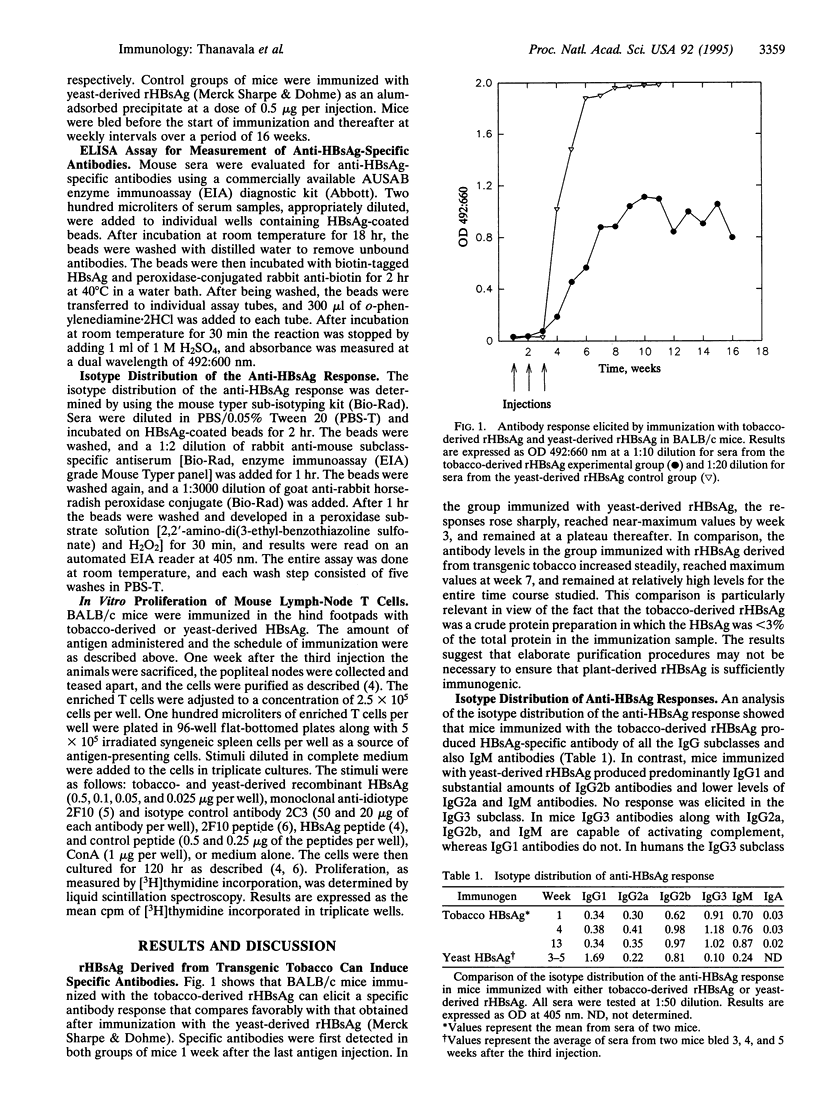Abstract
The focus of the Children's Vaccine Initiative is to encourage the discovery of technology that will make vaccines more readily available to developing countries. Our strategy has been to genetically engineer plants so that they can be used as inexpensive alternatives to fermentation systems for production of subunit antigens. In this paper we report on the immunological response elicited in vivo by using recombinant hepatitis B surface antigen (rHBsAg) purified from transgenic tobacco leaves. The anti-hepatitis B response to the tobacco-derived rHBsAg was qualitatively similar to that obtained by immunizing mice with yeast-derived rHBsAg (commercial vaccine). Additionally, T cells obtained from mice primed with the tobacco-derived rHBsAg could be stimulated in vitro by the tobacco-derived rHBsAg, yeast-derived rHBsAg, and by a synthetic peptide that represents part of the a determinant located in the S region (139-147) of HBsAg. Further support for the integrity of the T-cell epitope of the tobacco-derived rHBsAg was obtained by testing the ability of the primed T cells to proliferate in vitro after stimulation with a monoclonal anti-idiotype and an anti-idiotype-derived peptide, both of which mimic the group-specific a determinant of HBsAg. In total, we have conclusively demonstrated that both B- and T-cell epitopes of HBsAg are preserved when the antigen is expressed in a transgenic plant.
Full text
PDF



Selected References
These references are in PubMed. This may not be the complete list of references from this article.
- Alter M. J., Hadler S. C., Margolis H. S., Alexander W. J., Hu P. Y., Judson F. N., Mares A., Miller J. K., Moyer L. A. The changing epidemiology of hepatitis B in the United States. Need for alternative vaccination strategies. JAMA. 1990 Mar 2;263(9):1218–1222. [PubMed] [Google Scholar]
- Mason H. S., Lam D. M., Arntzen C. J. Expression of hepatitis B surface antigen in transgenic plants. Proc Natl Acad Sci U S A. 1992 Dec 15;89(24):11745–11749. doi: 10.1073/pnas.89.24.11745. [DOI] [PMC free article] [PubMed] [Google Scholar]
- Pride M. W., Shi H., Anchin J. M., Linthicum D. S., LoVerde P. T., Thakur A., Thanavala Y. Molecular mimicry of hepatitis B surface antigen by an anti-idiotype-derived synthetic peptide. Proc Natl Acad Sci U S A. 1992 Dec 15;89(24):11900–11904. doi: 10.1073/pnas.89.24.11900. [DOI] [PMC free article] [PubMed] [Google Scholar]
- Pride M. W., Thakur A., Thanavala Y. Mimicry of the a determinant of hepatitis B surface antigen by an antiidiotypic antibody. I. Evaluation in hepatitis B surface antigen responder and nonresponder strains. J Exp Med. 1993 Jan 1;177(1):127–134. doi: 10.1084/jem.177.1.127. [DOI] [PMC free article] [PubMed] [Google Scholar]
- Purcell R. H. Hepatitis viruses: changing patterns of human disease. Proc Natl Acad Sci U S A. 1994 Mar 29;91(7):2401–2406. doi: 10.1073/pnas.91.7.2401. [DOI] [PMC free article] [PubMed] [Google Scholar]
- Thanavala Y. M., Bond A., Tedder R., Hay F. C., Roitt I. M. Monoclonal 'internal image' anti-idiotypic antibodies of hepatitis B surface antigen. Immunology. 1985 Jun;55(2):197–204. [PMC free article] [PubMed] [Google Scholar]


